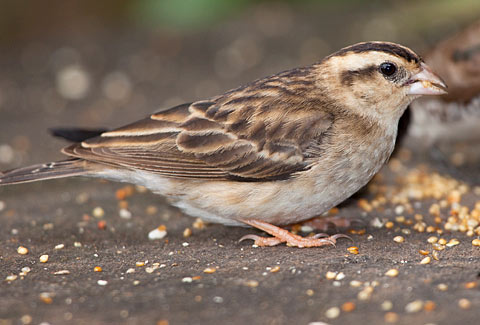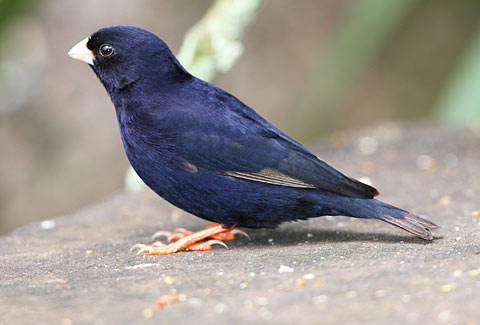
Vidua funerea
SUBFAMILY
Viduinae
TAXONOMY
Fringilla funerea de Tarragon, 1847, Natal.
OTHER COMMON NAMES
English: Black widow finch, variable indigobird; French: Combassou
variable; German: Purpuratlaswitwe; Spanish: Viuda
Variable.
PHYSICAL CHARACTERISTICS
4.3–4.7 in (11–12 cm), female 0.4–0.5 oz (12–16 g), male
0.5–0.6 oz (14–17 g). Breeding male black, with whitish bill
and red legs. Female and non-breeding male buff upperparts
with broad black stripes on head, whitish underparts. Juvenile
like female but head dark, unstriped.
DISTRIBUTION
Tanzania to eastern South Africa.
HABITAT
Grassy areas including fringes of cultivation, gardens, and
roadsides.
BEHAVIOR
Male sings from exposed perch for long periods, including
song and calls of African firefinch (Lagonosticta rubricata)
interspersed with chirping notes. Displays to female in a bobbing
flight. In non-breeding season birds associate in flocks,
join mixed flocks of other small seed-eaters, and become
nomadic.
Vol. 11: Birds IV Family: Weavers
FEEDING ECOLOGY AND DIET
Seeds, mainly collected on the ground, including buried seeds
dug out by scratching backwards with both feet.
REPRODUCTIVE BIOLOGY
Brood parasite, polygynous, with males at display sites which
females visit for mating. Lays one egg per host nest. Incubation
and fledging periods apparently unrecorded. Host is
African firefinch, and young of parasite specifically match
mouth markings of this species; male indigobirds learn vocalizations
of host while in nest, and later incorporate these elements
into their own song.
CONSERVATION STATUS
Not threatened. Locally common, with an extensive range in
Africa.
SIGNIFICANCE TO HUMANS
None known.
Other popular Animals
Photo Gallery of - Dusky indigobird




 Animalia Life
Animalia Life